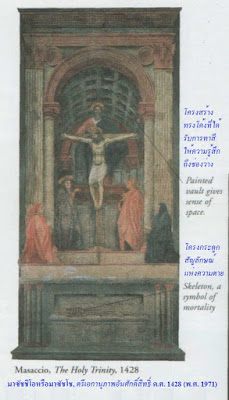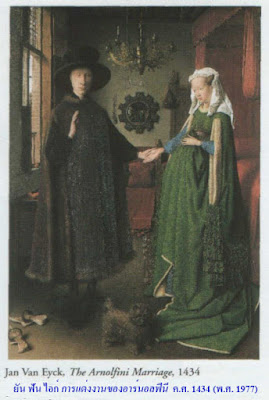HISTORY OF
ART
FROM THE
EARLIEST TIMES, people all over the world have expressed
their thoughts and feelings by making art.
Over the centuries, styles in the visual arts (sculpture, painting, and drawing) have changed. These differences reflect the
changing beliefs and traditions people held as their
societies developed. Materials have
changed as well, allowing artists to try new ways of
reflecting the world around them.
|
ประวัติศาสตร์ศิลปะ
นับตั้งแต่ยุคแรกสุด ผู้คนจากทั่วโลกได้แสดงความคิดเห็นและความรู้สึกของตนเองโดยการสร้างงานศิลปะ
ตลอดหลายศตวรรษที่ผ่านมามีการเปลี่ยนแปลงรูปแบบในทัศนศิลป์ (ประติมากรรม ภาพวาดและภาพเขียน)
ความแตกต่างเหล่านี้สะท้อนให้เห็นถึงความเชื่อที่เปลี่ยนแปลงและประเพณีซึ่งผู้คนยึดถือในขณะที่สังคมของพวกเขาพัฒนาขึ้น
วัตถุมีการเปลี่ยนแปลงเช่นกันทำให้ศิลปินสามารถทดลองใช้วิธีใหม่ในการสะท้อนโลกที่อยู่รอบตัวเขา
|
|||
Early art
The earliest works
of art usually seem to have had a religious or magical purpose: to represent a god, for example, or to bring a hunter
luck as he stalked animals.
|
ศิลปะยุคแรก
ผลงานศิลปะที่เก่าแก่ที่สุดดูเหมือนจะมีจุดประสงค์ทางศาสนาหรือไสยศาสตร์
ตัวอย่างเช่น เพื่อเป็นตัวแทนของพระเจ้าหรือเพื่อนำความโชคดีมาให้กับนักล่าสัตว์ในขณะที่ไล่ล่าสัตว์
|
|||
Sumerian sculpture
A rich artistic
tradition grew up in ancient Sumer (now southern Iraq) during the 3rd millennium BC. This statue, which shows a Sumerian ruler,
is carved from hard
stone. It represents the strength
and dignity of a good leader.
|
ประติมากรรมของชาวซูเมอร์
ประเพณีศิลปะที่อุดมสมบูรณ์รุ่งเรืองขึ้นในหมู่ชาวซูเมอร์โบราณ
(ปัจจุบันคือบริเวณตอนใต้ของอิรัก) ในช่วงสหัสวรรษที่ 3 ก่อนคริสตศักราช รูปปั้นนี้ซึ่งบอกให้รู้ว่าเป็นผู้ปกครองชาวซูเมอร์ แกะสลักจากหินแข็ง
เป็นตัวแทนของความแข็งแรงและศักดิ์ศรีของผู้นำที่ดี
|
Caves at Lascaux
These extraordinary
pictures of wild animals were painted in French
caves more than 17,000 years ago. The
outlines were painted by hand, and the vivid
colours were filled in by spraying pigment through tubes of bone.
|
ถ้ำลัสโก
ภาพสัตว์ป่าผิดธรรมดาเหล่านี้มีการวาดขึ้นในถ้ำในประเทศฝรั่งเศส
มากกว่า 17,000 ปีที่ผ่านมา
โครงร่างวาดด้วยมือและสีสันที่เจิดจ้าเต็มไปด้วยการพ่นสีผ่านท่อกระดูก
|
|
Classical art
Western European art
stems directly from the traditions of the ancient
Mediterranean world, and especially the art of ancient Greece and Rome. In particular,
sculpture from these civilizations is remarkably
lifelike, or
naturalistic, and concentrates on the human figure.
|
ศิลปะยุคคลาสิก
ศิลปะยุโรปตะวันตกเกิดขึ้นโดยตรงจากวัฒนธรรมประเพณีของโลกเมดิเตอร์เรเนียนโบราณและโดยเฉพาะอย่างยิ่งศิลปะของกรีกโบราณและโรม
โดยเฉพาะอย่างยิ่ง ประติมากรรมจากอารยธรรมเหล่านี้มองดูเหมือนจริงอย่างน่าประหลาดหรือเป็นธรรมชาติและมุ่งความสนใจไปที่รูปมนุษย์
|
|||
Roman
wall painting
Most
ancient paintings have not survived. This
one was preserved by volcanic ash at Pompeii. It shows figures from Roman mythology, and was painted on a wall to
decorate the interior of a Roman house.
|
จิตรกรรมฝาผนังของชาวโรมัน
ภาพวาดโบราณส่วนใหญ่ได้สูญสลายไป ภาพนี้ถูกเถ้าภูเขาไฟเก็บรักษาที่ปอมเปอี
แสดงให้เห็นภาพวาดจากเทพนิยายโรมันและวาดไว้บนผนังเพื่อตกแต่งภายในบ้านของชาวโรมัน
|
Hermes and Dionysus
This Greek marble
statue shows the messenger god, Hermes,
holding a baby Dionysus, the god of wine. The
work displays a sure knowledge of human anatomy,
such as the structure of bone and muscle. It also represents the human body as an
ideal form, at its peak of physical beauty.
It is believed to be by Praxiteles, the most
famous ancient Greek sculptor.
|
เฮอร์มีสกับไดอะไนซัส
รูปปั้นหินอ่อนของกรีกนี้คือเฮอร์มีส
เทพเจ้าผู้ส่งสารกำลังอุ้มเด็กน้อยไดอะไนซัส เทพเจ้าแห่งไวน์ ผลงานชิ้นนี้แสดงความรู้เกี่ยวกับกายวิภาคของมนุษย์เช่นโครงสร้างของกระดูกและกล้ามเนื้ออย่างชัดเจน
นอกจากนี้ยังหมายถึงร่างกายมนุษย์ในฐานะเป็นรูปร่างในอุดมคติ ณ จุดสูงสุดของความงามทางกายภาพ
เชื่อกันว่าปั้นโดยแพรกซิเทลีส (Praxiteles)
ซึ่งเป็นประติมากรกรีกโบราณที่มีชื่อเสียงที่สุด
|
|
Renaissance
After
the fall of the Roman Empire, Classical art was
considered too pagan for the Christian civilizations
which began to develop in Europe. By the 15th century,
painters, sculptors, and architects began to revive a
classical tradition in the arts, creating highly
lifelike Christian works of art. This
revival is called the Renaissance, from the French for "rebirth". It began in Italy and spread through Europe. Influential
artists included Michelangelo (1475-1564).
|
สมัยฟื้นฟูศิลปวิทยา
หลังจากการล่มสลายของจักรวรรดิโรมัน
ศิลปะยุคคลาสสิกถือว่าเป็นพวกนอกศาสนาอย่างมากสำหรับอารยธรรมคริสเตียนที่เริ่มพัฒนาในยุโรป
ประมาณศตวรรษที่ 15 จิตรกร ประติมากรและสถาปนิกได้เริ่มต้นฟื้นฟูประเพณีดั้งเดิมในศิลปะ
ซึ่งเป็นการสร้างผลงานศิลปะคริสเตียนแท้ ๆ การฟื้นฟูนี้เรียกว่า Renaissance (เรอแนซ็องส์ - ยุคฟื้นฟูศิลปวิทยา) มาจากภาษาฝรั่งเศส แปลว่า "การเกิดใหม่"
เริ่มขึ้นในอิตาลีและแผ่กระจายไปทั่วยุโรป ศิลปินที่มีอิทธิพล ได้แก่ มีเกลันเจโล (Michelangelo
– มีชีวิตระหว่าง ค.ศ. 1475-1564 = พ.ศ. 2018 – 2107 อายุ 89 ปี)
|
|||
Perspective
The Italian Tomaso Masaccio (1401-28) was the first painter to use perspective since Classical times. Perspective creates the illusion that
depth exists behind the flat surface
of a painting.
|
เทคนิควาดภาพแบบที่มีสัดส่วนอย่างที่มองเห็น
ตอมาโซ มาซัชชีโอ (Tommaso Masaccio - มีอายุระหว่าง ค.ศ. 1401-28 = พ.ศ. 1944 – 1971 อายุ 27 ปี) ชาวอิตาลี
เป็นจิตรกรคนแรกที่ใช้เทคนิควาดภาพแบบที่มีสัดส่วนอย่างที่มองเห็นตั้งแต่ยุคคลาสสิก
เทคนิควาดภาพแบบที่มีสัดส่วนอย่างที่มองเห็นสร้างภาพลวงตาว่ามีความลึกอยู่ด้านหลังพื้นผิวเรียบของภาพวาด
|
Non-religious art
During
the Renaissance, European painters broke with
earlier tradition.
Religious
subject matter, such as scenes from the Bible,
was still important
but
artists also began to record everyday events.
|
ศิลปะที่ไม่ใช่ศาสนา
ในช่วงยุคฟื้นฟูศิลปวิทยา จิตรกรชาวยุโรปตีตัวออกห่าประเพณีก่อนหน้านี้
สาระสำคัญเกี่ยวกับศาสนา เช่น ฉากจากพระคัมภีร์ไบเบิล ยังคงมีความสำคัญ แต่ศิลปินก็เริ่มบันทึกเหตุการณ์ในชีวิตประจำวัน
|
|
Early
paint making
The
materials used to produce a painting affect the way it
looks. Before oil paints arrived in the 15th
century, artists worked straight onto wet plaster with tempera, a mixture of egg and paint
pigment. Oil paints, which were
more flexible and gave a more realistic finish, soon became the favourite medium.
|
การทำสีในยุคแรก
วัสดุที่ใช้ในการผลิตภาพวาดมีผลต่อลักษณะที่ปรากฏ
ก่อนที่สีน้ำมันจะเกิดขึ้นในศตวรรษที่ 15 ศิลปินทำงานโดยตรงต่อปูนปลาสเตอร์เปียกที่มีอุณหภูมิ
มีไข่และสีรงควัตถุเป็นส่วนผสม
สีน้ำมันซึ่งมีความยืดหยุ่นมากขึ้นและให้ภาพสมจริงมากขึ้นในไม่ช้าก็กลายเป็นวิธีการอันเป็นที่ชื่นชอบ
|
||||||||
|
|
|
|||
|
Egg tempera
Egg (either
the yolk or both yolk and white) provides
a strong medium for colours, but is
sticky and quick-drying, so
difficult to apply.
Oil
paint
As
a medium, oil has the advantage of being slow to dry, allowing artists to make changes
while they work.
|
สีฝุ่นเทมเพอรา
ไข่ (ไข่แดงหรือทั้งไข่แดงและไข่ขาว)
เป็นตัวกลางที่เข้มแข็งให้กับสี แต่เหนียวและแห้งเร็ว ใช้ยากมาก
สีน้ำมัน
ในฐานะเป็นตัวกลาง น้ำมันจะมีข้อดีคือแห้งช้า
ทำให้ศิลปินทำการเปลี่ยนแปลงได้ในขณะที่กำลังทำงาน
|
|
Value of colour
Certain colours,
such as gold, have always been more expensive than others. Until the 17th century, dark blue was the most costly because it
was made from lapis
lazuli, a semi-precious stone.
|
คุณค่าของสี
สีบางอย่าง
เช่น สีทอง มักมีราคาแพงกว่าสีอื่น ๆ จนถึงศตวรรษที่ 17 สีน้ำเงินเข้มเป็นสีที่แพงที่สุด ทำจากแลพิสแลซูลี (lapis lazuli) ซึ่งเป็นรัตนชาติกึ่งสูงค่า (semi-precious stone)
|









